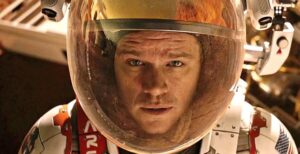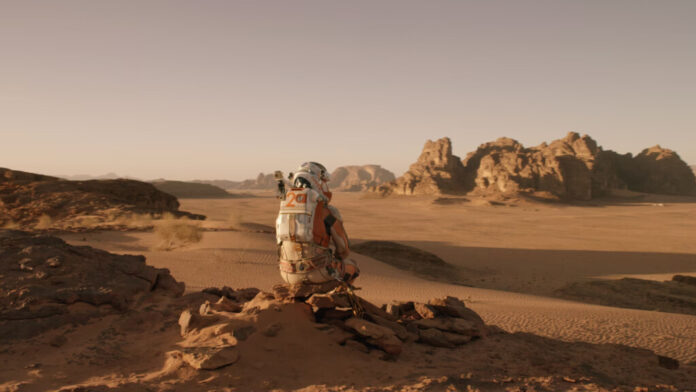Stranded, isolated, and left for dead amongst the barren sandy deserts of Mars, Mark Watney (Matt Damon), struggles to survive amongst the sea of nothingness. Separated from his crew during an intense sand storm, he faces the insurmountable challenge of surviving alone on Mars, with supplies for the mission intended to only feed the crew for a month, he now has to figure out how to sustain himself before he may even attempt to return home to Earth.
Visuals
Ridley Scott’s 2016 film, The Martian, being a relatively modern film features the employment of cameras and technologies capable of producing a higher-quality film. The technical quality of the film is drastically improved and higher when analyzed in comparison to other films such as the classical and older films of Seven Samurai and 2001: A Space Odyssey. Some changes other than obvious technological advancements in cameras and capturing techniques include a drastic improvement in image resolution and the film’s overall resolution and portrayal. Additionally, other components that comprise the film have also drastically advanced such as the enhancement of visual and graphical effects which coincide with newer editing technologies. Lighting and color are more in-depth and accurate in comparison to these older films. Another major development is the audio quality the film features, with various realistic sound effects and music to support it. The film featured an improvement of mise-en-scene and utilization of detailed props, setting, and environmental construction that accompanies the budget of a modern blockbuster production.

Audio
Scott’s employment and audio usage masterfully convey and depict Mark Watney’s predicament of isolation and futility associated with his stranding on Mars. Some techniques that are used to achieve this desired effect include other techniques such as shot types and zoom. An example of this is the use of music to create tension in a scene, the music works in conjunction with the sound effects such as the howling wind and dust. Ridley’s use of abrupt stops in the music also creates suspension and tension by subverting the audience’s expectations and premonitions. His utilization of zoom achieves the purpose of demonstrating the immense scale of Watney’s isolation from any other source of humanity.

Staple of the Genre
Ridley’s Scott’s, The Martian, has some similarities and features in common with the classic of 2001: A Space Odyssey, the film that ignited the science fiction genre. One aspect that does differ between the two films is their depiction of space travel. A Space Odyssey displays it in a nature that is seamless, elegant, and efficient exemplified through the presence of PanAm space transport services. This contrasts the difficulty and reality of space travel portrayed in The Martian.
Scott’s use and utility of audio within the film are iconic and a defining aspect of the film. The sound effects were advanced and highly detailed and provided in-depth additional detail to every scene in which it was present. A highly memorable sound effect that is omnipresent throughout the film was the lashing of dust and sand on the shelter, it represented the strength and constant threat that the elements and environment of Mars Watney faced. The audio is significantly enhanced in terms of sound effects which immerse the audience and provide extra detail, and music which Ridley used to set tones and moods throughout the film.
Stay tuned to the Roundup for more movie coverage!






